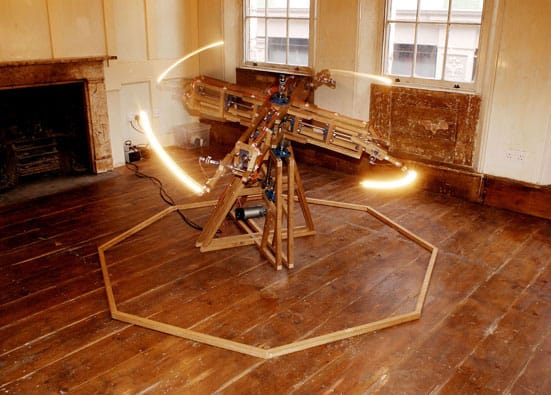20th November 2006 — 12th January 2007
Once
upon a time there was a trendy gallery called Indica. It
never made any money but was where all the hip young things
hung out - no doubt making the whole experience extremely
cool but not helping pay the rent so it shut after two
years in 1967. Marc Bolan painted the walls but he probably
did a lot of lousy jobs and Polanski visited but he went
to lots of places. More importantly Indica showed some
really interesting, cutting edge art by unknown artists.
Riflemaker becomes Indica seeks to juxtapose the works
of some of the original artists with some contemporary
pieces. Describing the present art climate as 'harsher,
more cynical and much more business-orientated' it steps
up as an example of this 'cultural scene'. Although there
may have been work shown at Indica that would now be more
cringeworthy than praiseworthy enough big hitters passed
through the doors to be able to present some iconic works.
This exhibition could have become a kind of competition,
or worse, a kind of 'homage', but it doesn't do either.
It is a remarkably even show with new and old works complimenting
each other well around the vague theme of kinetics. There
is an innocence and simplicity with rather less of the
aforementioned cynicism. Dominating the upstairs room is
an elegant, wooden contraption by Conrad Shawcross with
four light bulbs on arms thrashing round. They are all
geared from the same motor with old-school cogs, gears
and mercury bushes. This was built in 2006 but blends perfectly
with the older works as well as the rough wooden floors
and olde worlde charm of the building itself. The wall
text talks of 'the afterimage' but I was more enthralled
with the danger of the beast, applying the rather laxer
health and safety requirements of the mid 60s perhaps.
More elegant apparatus runs some flickerbook machines of,
what appears to be, mobile phone footage of some blokes
in a street. The room is competed with three lights on
poles and a cut and paste text piece.
On the ground floor
are a number of multicoloured floor to ceiling forms made
from resin and wire. Had these been made forty years ago
they may have been exciting but now they resemble 'crafty'
lamps. Yoko Ono's apple is the only piece that was shown
in the original Indica gallery. Obviously it is not the
same apple, firstly because it is a nice fresh Granny Smith's
and secondly because when it was shown initially some arrogant
Scouse philistine came along and took a bite out of it.
Ono must have been furious, you just don't need that kind
of grief at your private view. I'm sure Lennon tried to
justify it but it was totally out of order and he's lucky
that she ever gave him the time of day again. As a piece
it displays a deft use of materials - a nice shiny green
apple sitting, like a logo, on a crystal clear (and space-age
modern at the time) plinth.
The Boyle family reproduced
randomly chosen 6' squares of the earth that are displayed
as wall pieces. The one we have here has 1 1/2 drain covers,
some bits of glass and a gutter. I have always had a mental
picture of the Brady bunch heading off to a set of co-ordinates
only to discover again that it is: A. in a huge building
B. on a 'secret' government base C. in the sea. A few contemporary
abstract/op-art paintings fill up the rest of the wall
space.
I cracked my head something rotten going into the
basement adding to the dizzying effect of flashing lights
and jumping shadows - I recommend you do the same. Once
again the work here is simple and elegant. Lights in the
frame of 'Cosmic Flares III' 1966 are turned on and off
by cams. By the stairs are a series of extremely watchable
films by Peter Whitehead. The vibe in these swings from
past to present with interviews with 'dolly birds' on funfair
rides and films of the horseguards parade and fainting
guardsmen. At one point two quaint bobbies run over and
tell him off for filming.
Indica was a welcoming, open
space that encouraged discourse. Riflemaker isn't - the
door is sometimes locked and, while most members of staff
were extremely friendly and helpful, sometimes the original
spirit 'collaboration and fluidity' seems lacking, exchanged
perhaps for one more 'business-orientated'. Ring the bell
and wait though because this exhibition is well worth a
visit. There will be a second part of this show in January
and there are a series of talks and happenings programmed.
Could any contemporary gallery make such a mark as Indica
and be remade in 2050 to the same effect? I doubt it.
AL
Riflemaker
79 Beak Street
London W1F 9SU
http://www.riflemaker.org/
Open
Monday-Friday, 10am-6pm
Saturday, 12pm-6pm

Conrad Shawcross, Counterpoint: Piano:(Second 9:8)
2006 140 x 140cm
Mixed Media Photo- Chris McAndrew